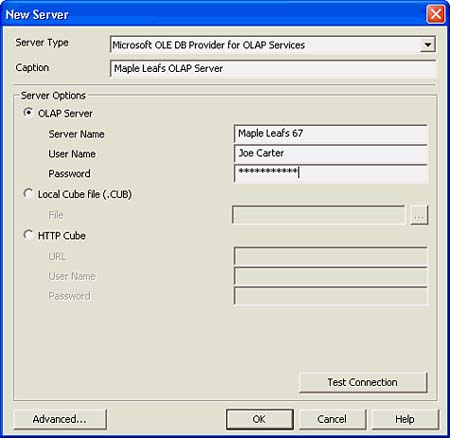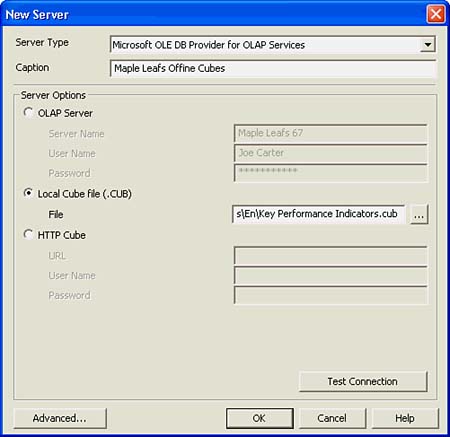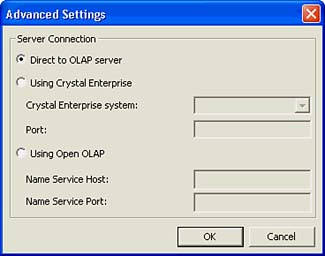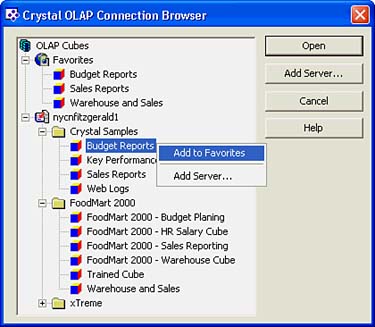Accessing OLAP Data with Crystal Analysis
After starting Crystal Analysis through the Application Designer option on the Start Programs Crystal Analysis menu, you can create new Crystal applications by choosing File, New. Similar to Crystal Reports Report Gallery, Crystal Analysis provides a set of application templates and wizards as potential starting points in addition to the option of starting from a blank application (see Figure 19.3). This chapter focuses on the manual process of creating analytic applications from the ground up but you are encouraged to review the application templates and their associated wizards to determine if a fit exists.
Figure 19.3. You can select a template in the New Application dialog.

After you select the Blank Application option, Crystal Analysis prompts you with the OLAP Connection Browser shown in Figure 19.4. This is the equivalent of the Data Explorer in Crystal Reports and enables the user to select an OLAP data source on which to base the report.
Figure 19.4. The Crystal OLAP (and Analytic Business View) Connection Browser enables data source specification.

From the Crystal OLAP Connection Browser window, you can add new OLAP servers to the tree using the Add Server button. This then displays the New Server dialog shown in Figure 19.5. There are several ways to connect to a cube, all of which can be defined through this dialog.
Figure 19.5. Add an OLAP server connection to the Crystal OLAP Connection Browser.

Creating an OLAP Server Data Source
After you select the Add Server button, the New Server dialog appears. The first option in this window is OLAP Server, which defines a regular client/server connection to the OLAP Server and does not change across the different versions of supported cubes. This is the most common type of connection and is compatible with thin-client delivery when Crystal Enterprise and the OLAP Database Server are on the same side of the firewall.
Figure 19.5 shows this type of server being defined in the New Server dialog for a SQL Server Analysis Services cube. Select Microsoft OLE DB driver for OLAP Services as the Server Type, and then type the server name into the Server Name box and ensure the caption is appropriately filled in. The caption can be changed to give the server a more descriptive name.
Adding Local Cube (.cub) Files as Data Sources
SQL Server Analysis Services enables a user to create an offline cube file containing a subset of the data held in SQL Server. These cubes can be accessed using Crystal Analysis Professional when the user is away from the network—for example, when traveling with a laptop. Figure 19.6 shows a .cub file being selected in the New Server dialog. The Browse button (ellipses) enables users to navigate through their directories to locate the .cub file. A caption has been defined to make the entry in the OLAP Connection Browser more readable.
Figure 19.6. Add a .cub file to the OLAP Connection Browser.

Adding HTTP Cubes Data Sources
HTTP cubes, which are sometimes called iCubes, enable the transport between PTS and Microsoft SQL Server to be tunneled through HTTP, allowing connections through firewalls and proxy servers. Figure 19.7 shows an HTTP connection selected in the New Server dialog. To establish a valid connection to an HTTP Cube server you must specify the full URL, including the http or https prefix. A username and password can optionally be specified. For HTTP cubes, the server checks the authentication of the user who requests the connection. If the password or username is incorrect or blank, the server defines how an anonymous user is logged on.
Figure 19.7. Add an HTTP cube server to the OLAP Connection Browser.

NOTE
HTTP cubes were introduced in Microsoft SQL Server 2000 and require Microsoft Internet Information Server (IIS) to be used as the Web server. For more information, see Microsoft's documentation for Analysis Services, which is available either as part of your Microsoft OLAP installation or on the MSDN Web site at http://msdn.microsoft.com/library/.
Advanced Data Source Connectivity
On the New Server dialog, an Advanced Data Source connectivity button is presented that enables you to specify a connection type. Figure 19.8 shows the Advanced Settings dialog, which provides three different options for connectivity to cubes. The Direct to OLAP Server option is almost exclusively used at this time, but the other two forms of connectivity are used currently for connectivity to legacy Holos cubes.
Figure 19.8. The Advanced Settings are almost exclusively set to Direct to OLAP Server.

NOTE
If you need more information on this type of legacy connectivity, please consult your Crystal Analysis and Holos help files.
Favorite Cubes
Favorite cubes are a feature of Crystal Analysis that enables users to create shortcuts to frequently used cubes. You create shortcuts by simply dragging a cube into the Favorites folder from within the Crystal OLAP Connection Browser window (see Figure 19.9). Once defined, a shortcut can be renamed if required.
Figure 19.9. Create a shortcut to a favorite cube.

